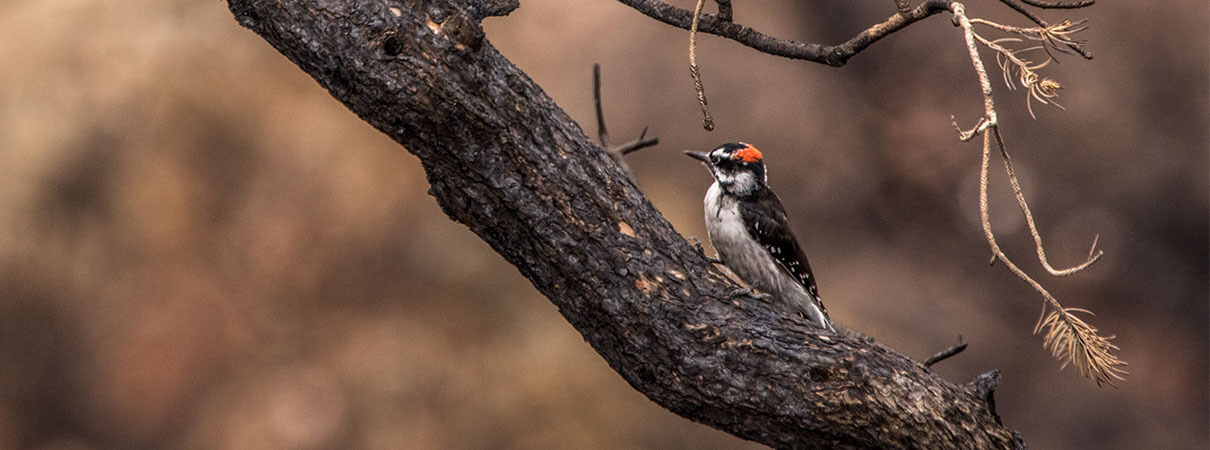Fire and Birds: What Does California's Camp Fire Mean for Birds?
On November 8, 2018, the Camp Fire started in the foothills of California's Sierra Nevada mountains. Caused by a downed powerline, it rapidly spread to affect 153,000 acres, tragically killing at least 85 people, mostly in the town of Paradise, and destroying 18,000 homes and other buildings. It finally burned out after rains on November 25. It was the deadliest fire in California's history and has become a defining event in the future of forest management in the West.
This March, the state of California announced a plan to speed up thinning on 90,000 high-risk acres for fire prevention, but such catastrophic fires are also leading to greater pressure to increase logging on federal lands across the state more broadly.
I visited several fire-affected areas in the Sierras this February, aiming to get a clearer understanding of how response to such fires will impact bird conservation. The issue of fire, forestry, and birds is complex, but ABC is not afraid to grapple with challenging topics, and working together with partners and listening to local communities are critical aspects of our work to get results for birds.

White-headed Woodpecker. Photo by Michael J. Parr.
During the visit, David Younkman, ABC's Vice President for the Western Region, and I met representatives of Cal Fire (the California Department of Forestry and Fire Protection), the U.S. Department of Agriculture, local biologists and forest management professionals, and homeowners in at-risk communities.
Although there is not yet complete consensus on what should be done to prevent such disasters in the future, one thing is for sure: This fire has elevated and forever changed the conversation about forest management in California — and the outcome of that conversation will fundamentally impact how birds fare in western and perhaps all American forests.
Conventional wisdom is that, due to fire suppression, western forests are overloaded with “fuel” and that until this is burned off, we will face an increasing number of atypically intense fires that have the potential for enormous damage. This is being compounded by climate change, which has caused the recent droughts and associated outbreaks of native pine bark beetles that infest drought-stricken trees, making them yet more vulnerable to fire.

Satellite image of Camp Fire. Photo by NASA.
The obvious conclusion is that fires will continue to worsen unless trees and other fuel are removed through mechanical means and prescribed burns. However, some biologists are now questioning historical patterns, and suggesting that intense fires have likely long been a feature of these forests. Another major question concerns “salvage logging,” or cutting partially burned timber for sale following a fire.
It would be incredibly difficult to find the time or resources to conduct forest clearance at a large enough scale to achieve fire prevention that protects communities — unless that clearance is conducted in their immediate vicinity. The environmental cost of such an endeavor would also be enormous. For example, many birds rely on natural fires of varied intensities, which create a diversity of habitat types, including areas with burned, standing trees and regenerating early successional vegetation.
While on the edge of Yosemite National Park, at a location impacted by the 2013 Rim Fire, we witnessed ongoing mechanical removal of burned trees in the vicinity of a Great Gray Owl territory. Many cavity-nesting birds such as White-headed and Black-backed Woodpeckers also depend on these burned trees, and Spotted Owls, too, can forage in recently burned areas.
In addition, salvage logging may not even help to prevent fire: The Camp Fire, for example, spread directly through a salvage-logged area.

Downy Woodpecker. Photo by Rachel Portwood/Shutterstock.
What can be done then to manage forests to protect communities while also conserving habitat for fire-dependent birds? My takeaway from a heart-wrenching drive through the wreckage of Paradise is that concentrating on the removal of trees close to high-risk communities and creating defensible space around homes that are better fire-proofed, will surely be more effective than large-scale timbering and salvage logging on public lands throughout the Sierras. It will also be substantially better for birds that depend on this structurally diverse, fire-dependent ecosystem.
ABC plans to work with the Natural Resources Conservation Service to recommend best management practices for birds on private lands managed to prevent fire in the Sierra foothills as a next step for our direct engagement. We will report on our progress in future issues of Bird Conservation.
 Michael J. Parr is President of American Bird Conservancy.
Michael J. Parr is President of American Bird Conservancy.


















































